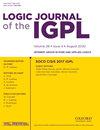关于定义Kripke框架的n密度或有界n宽度所需的不同变量的数量,以及Sahlqvist公式的一些结果
IF 0.8
4区 数学
Q2 LOGIC
引用次数: 0
摘要
我们证明了Kripke框架的n$-密度和有界的n$-宽度不仅可以用自然的和众所周知的包含线性数量不同命题变量的Sahlqvist公式,而且可以用包含对数数量不同命题变量的多项式长度公式进行模态定义,然后我们证明了这种变量数量的指数减少使我们超出了Sahlqvist公式的范畴。本文章由计算机程序翻译,如有差异,请以英文原文为准。
On the number of different variables required to define the n-density or the bounded n-width of Kripke frames with some consequences for Sahlqvist formulae
We show that both the $n$-density and the bounded $n$-width of Kripke frames can be modally defined not only with natural and well-known Sahlqvist formulae containing a linear number of different propositional variables but also with formulae of polynomial length with a logarithmic number of different propositional variables and then we prove that this exponential decrease in the number of variables leads us outside the class of Sahlqvist formulae.
求助全文
通过发布文献求助,成功后即可免费获取论文全文。
去求助
来源期刊
CiteScore
2.60
自引率
10.00%
发文量
76
审稿时长
6-12 weeks
期刊介绍:
Logic Journal of the IGPL publishes papers in all areas of pure and applied logic, including pure logical systems, proof theory, model theory, recursion theory, type theory, nonclassical logics, nonmonotonic logic, numerical and uncertainty reasoning, logic and AI, foundations of logic programming, logic and computation, logic and language, and logic engineering.
Logic Journal of the IGPL is published under licence from Professor Dov Gabbay as owner of the journal.

 求助内容:
求助内容: 应助结果提醒方式:
应助结果提醒方式:


